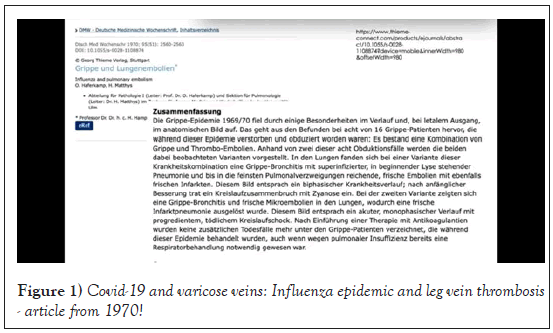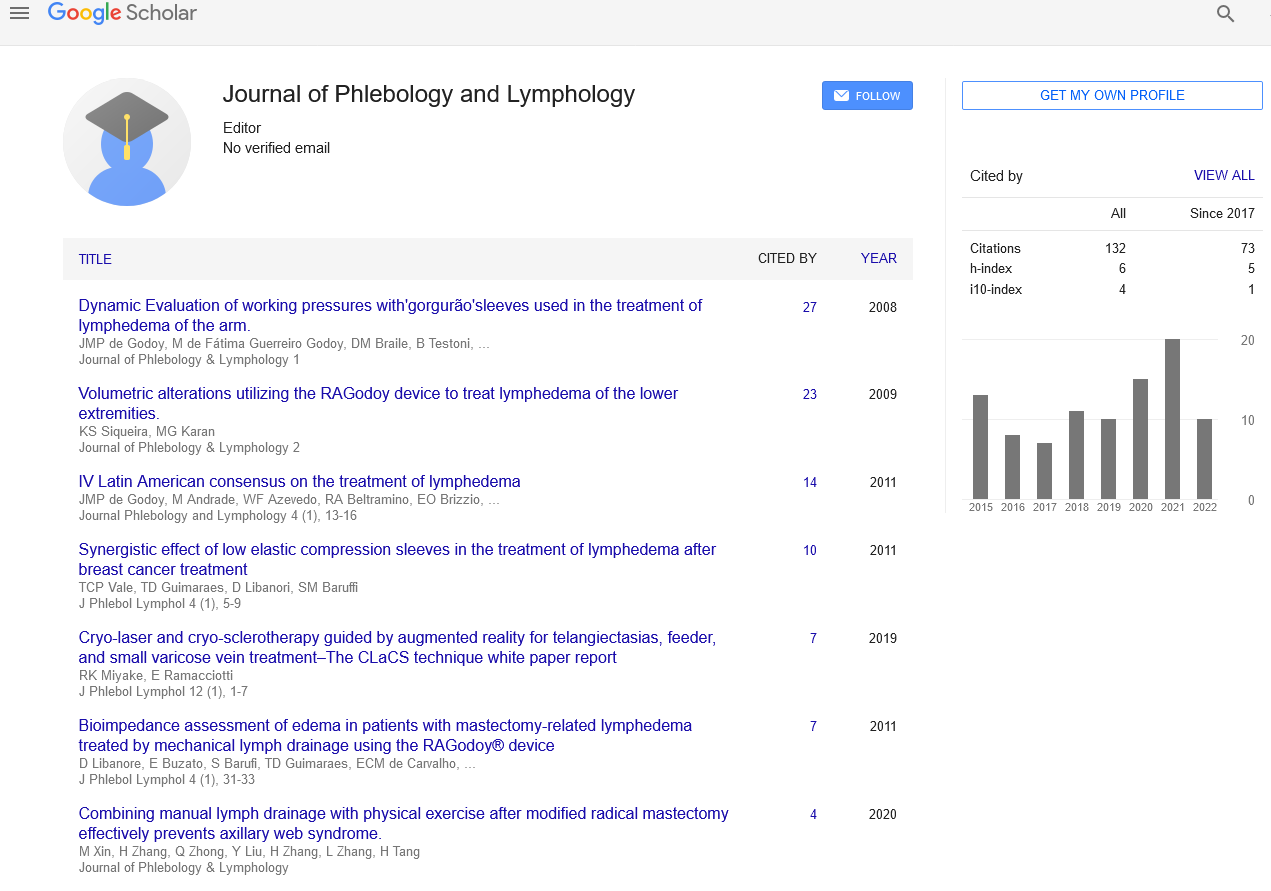Covid 19 and Varicose Veins: Common Causes of Deep Vein Thrombosis and Embolism
Received: 22-Oct-2020 Accepted Date: Nov 04, 2020; Published: 11-Nov-2020
This open-access article is distributed under the terms of the Creative Commons Attribution Non-Commercial License (CC BY-NC) (http://creativecommons.org/licenses/by-nc/4.0/), which permits reuse, distribution and reproduction of the article, provided that the original work is properly cited and the reuse is restricted to noncommercial purposes. For commercial reuse, contact reprints@pulsus.com
Abstract
Covid-19 has a strong inflammatory effect on vein walls. Together with other risk factors, Covid-19 infection creates a major thrombogenic risk. Using a case description, we shed light on the vascular surgical view of the clinical and therapeutic problems.Keywords
Varicose Veins; Deep Vein Thrombosis; Embolism
Introduction
The risk factors for superficial vein thrombosis (OVT) are close to those for Venous Thromboembolism (VTE). However, the risk of these superficial cutaneous vein thromboses is considerably higher if there are already varicose veins (defective venous valves with a subsequent standing blood column and pathological backflow into the lower leg veins!). This reflux increases the pressure in the deep veins to over 100 mmHg - and with that alone there is a high risk of thrombosis. Now a virus is added, which obviously accumulates and multiplies in all inner walls of the vessels. This also applies to the vascular wall of varicose veins [1-5].
Case Study
Pathophysiological considerations: COVID-19 and varicose veins: common cause of deep vein thrombosis and embolism
As can already been read in some publications, COVID-19 causes inflammation of the vascular wall of the deep leg veins - this alone has a thrombotic effect. In this case, however, the question must be asked whether the vein wall inflammation of the varicose vein does not exist first and whether the superficial thrombosis, which therefore develops very quickly, migrates into the deep veins of the leg, which have already been damaged by the virus. This then leads to the, often fatal pulmonary embolism, currently with Covid-19. However, this pathological process was discussed 50 years ago and can be found in our literature research in many older scientific articles (Figure 1).
Figure 1: Covid-19 and varicose veins: Influenza epidemic and leg vein thrombosis - article from 1970!
Varicose veins are the main cause of OVT of the lower extremities, but underlying diseases (e.g. autoimmune diseases, infections, malignancy or thrombophilia) that already exist in parallel must also be looked for in superficial cutaneous vein thrombosis [6-8]. A simultaneous deep vein thrombosis after cutaneous vein thrombosis of varicose veins occurs in 15% of all affected. The severe complication pulmonary embolism can be seen in around 5% of those affected. However, these numbers do not yet take into account the pathological influence of various viruses - such as Covid-19 (Table 1).
| Basel study of 4,529 apparently healthy workers | ||
|---|---|---|
| ♀ | ♂ | |
| 44% | 76% | "Beinbeschwerden" |
| 6% | 14% | Phlebitis |
| 2% | 3% | Lungenembolie |
| 56% | 55% | Varikose |
| 20% | 11% | Stammvarikose |
| (Besenreiser oder retikulare Varizen ♂ 3mal,♀ 4mal haufiger als die Stammvarikose) Chronisch-venose Insuffizienz bei 15% (♂ ♀ gleich), |
||
| Davon | 6% mit Hautveranderungen | |
| und | 1% mit Ulcus cruris. | |
| Altersabhangigkeit: | ||
| Alteste | 5mal haufiger | Beschwerden Phlebitiden Lungenembolien |
| 10mal haufiger | Varikose chronisch-venose Insuffizienz |
|
Table 1: Basler Studie bei 4529 scheinbar gesun-den Berufstatigen (aus 164)
Many viral infections (Influenza, HIV, Varicella, Covid-19) are associated with coagulation disorders. All aspects of the coagulation cascade, hemostasis, coagulation, and thrombosis dissolution can be affected. As a result, thrombosis and bleeding can occur in all vascular regions. The investigation of coagulation disorders as a result of various viral infections were not carried out uniformly. Common paths are therefore not fully understood. For many severe viral infections, there is no other treatment than supportive measures. We have already suggested some ways of doing this [9].
COVID-19 and varicose veins: A recent patient story
A 59-year-old patient with pronounced varicose veins presented to our practice in mid-May 2020. The medical history included pneumonia as a result of pulmonary embolism in a coronavirus infection.
In the conversation with the patient, our patient reported on several previous operations on the varicose veins left. 6 and 7 years ago and in the more recent past of superficial vein thrombosis in the area of recurrent varicose veins on the left leg. She then had to be treated with a deep vein thrombosis. The pneumonia set in about 14 days after the cutaneous vein thrombosis; she initially did not notice the pulmonary embolism. When she was admitted to a Berlin hospital, the corona infection was found [10-13].
The infection has now healed, the deep veins have recanalized - we recommended that our patient rehabilitate the cutaneous vein system using VenaSeal® venous glue and micro-foam therapy. This was done successfully with described therapy techniques in September this year!
Results and Discussion
COVID-19 and varicose veins: Our discussion
In addition to all these aspects, doctors need to keep an eye on something else. In the case of Covid-19, various mechanisms can lead to blood coagulation being disturbed. This can manifest itself in a pulmonary embolism, for example. In this complication, a blood clot blocks one or more arteries in the lung. Autopsy results suggest that some of these thrombi have their origin in the deep leg veins (Annals of Internal Medicine: Wichmann et al.). From there, they are carried away with the bloodstream and flushed into the lungs [14].
Depending on how big the blood vessel is that it is blocking in the lungs, an embolism can be fatal within a short time - this seems to be more common with Covid-19 than initially assumed. But it can also cause long-term damage. If such a pulmonary embolism does not completely regress, it can lead to pulmonary hypertension. In this case, one really has to speak of long- term damage. The clot increases the resistance in the pulmonary circulation against which the heart has to pump. In the long run, the right part of the heart is increasingly overwhelmed by this, the patients are exhausted with the slightest effort, gasp for air, complain of water in their legs and dizziness. Life expectancy is also limited in many cases by pulmonary hypertension [15].
COVID-19 and varicose veins: Therapeutic recommendations from a vascular surgeon`s point of view
It is very important for us - as vascular surgeons - to point out that Covid-19 is not the first virus with these significant thromboembolic - sometimes fatal - side effects. There are other risk factors too! And in any case, this also includes varicose veins, which are generally not considered so much from the point of view of illness. In terms of viral complications, these represent an easy target and are the cause of very rapid thrombosis and embolism [16-23].
Conclusion
In conclusion, we urgently recommend our patients not only to address this problem in times of viral pandemics. Function and cosmetics are important factors; complications as a result of varicose veins cannot be planned or predicted! These results in the recommendation for specialist diagnostics and necessary therapy with the various therapy methods recommended today!
We are very grateful our Saphenion® - Senior Consultant, PD Dr. Wolfgang Lahl for his suggestions and for sending older literature sources!
Conflict of Interest Statement
The Authors have not any conflict of interests.
REFERENCES
- Decousus H, Epinat M, Guillot K, et al. Superficial vein thrombosis: Risk factors, diagnosis, and treatment. Curr Opin Pulm Med. 2003;9(5):393‐7.
- Maruyama H, Okugawa H, Takahashi M, et al. De Novo portal vein thrombosis in virus-related cirrhosis: Predictive factors and long-term outcomes. Am J Gastroenterol. 2013;108(4)568-74.
- Filis K, Kavantzas N, Dalainas I, et al. Evaluation of apoptosis in varicose vein disease complicated by superficial vein thrombosis. Vasa. 2014;43(4):252‐9.
- Wijarnpreecha K, Thongprayoon C, Panjawatanan P, et al. Hepatitis C Virus Infection and Risk of Venous Thromboembolism: A systematic review and meta-analysis. Ann Hepatol. 2017;16(4):514-20.
- Jerkic Z, Karic A, Karic A. Clinically silent deep vein thrombosis in patients with superficial thrombophlebitis and varicose veins at legs. Med Arh. 2009; 63(5):284-7.
- Karathanos C, Spanos K, Saleptsis V, et al. Recurrence of superficial vein thrombosis in patients with varicose veins. Phlebology. 2016; 31(7):489‐95.
- Khan R, Yasmeen A, Pandey AK, et al. Cerebral venous thrombosis and acute pulmonary embolism following varicella infection. Eur J Case Rep Intern Med. 2019; 6(10):001171.
- Nicolaides A, Hull RD, Fareed J, et al. Superficial vein thrombosis [published correction appears in Clin Appl Thromb. Hemost. 2013;19(3):341;208‐13.
- Oliveira GN, Basso S, Sevivas T, Neves N. Varicella complicated by cellulitis and deep vein thrombosis. BMJ Case Rep. 2017; 2017:bcr2017221499.
- Ramacciotti E, Agati LB, Aguiar VCR, et al. Zika and Chikungunya Virus and Risk for Venous Thromboembolism. Clin Appl Thromb. Hemost. 2019; 25 1076029618821184.
- M Goeijenbier , M van Wissen, C van de Weg, et al. Review: Viral Infections and Mechanisms of Thrombosis and Bleeding. J Med Virol. 2012;84(10):1680-96.
- M van Rij A, Chai J, Hill GB. Incidence of deep vein thrombosis after varicose vein surgery. Br J Surg. 2004;91(12):1582‐5.
- Warot M, Synowiec T, Wencel-Warot A, et al. Can deep vein thrombosis be predicted after varicose vein operation in women in rural areas? Ann Agric Environ Med. 2014;21(3):601‐5.
- Zierau UT, PD Dr. med. W.Lahl, Lillie Martell. Saphenion Patienteninfo: Leitlinien Krampfadertherapie. 2019.
- Zierau, Ulf Th. Saphenion Patienteninfo: Leitlinien Krampfaderverödung. 2019.
- Zierau, Ulf Th. Das Covid-19 High Noon: Thrombose – Lungenembolie. 2020.
- Rätselhafte Blutgerinnsel bei COVID-19-Patienten. 2020.
- Varga Z, Flammer AJ, Steiger P, et al. Endothelial cell infection and endotheliitis in COVID-19. 2020;395(10234):1417-18.
- Connors JM , H Levy JH. COVID-19 and its implications for thrombosis and anticoagulation. Blood. 2020;135(23):2033-40.
- Bikdeli B, Madhavan MV, Jimenez d, et al. COVID-19 and Thrombotic or Thromboembolic Disease: Implications for Prevention, Antithrombotic Therapy, and Follow-Up: JACC State-of-the-Art Review. J Am Coll Cardiol. 2020;75(23):2950-73.
- Tichelaar YIGV, Kluin-Nelemans HJC, Meijer K, et al. Infections and inflammatory diseases as risk factors for venous thrombosis. A systematic review. Thromb Haemost. 2012;107(5):827-37.
- Obi AT, Tignanelli CJ, Jacobs BN, et al. Empirical systemic anticoagulation is associated with decreased venous thromboembolism in critically ill influenza A H1N1 acute respiratory distress syndrome patients. J Vasc Surg Venous Lymphat Disord.2019;7(3):317-24.
- Martins de Medeiros D, Silva CA, Bueno C, et al. Pandemic influenza immunization in primary antiphospholipid syndrome (PAPS): a trigger to thrombosis and autoantibody production? Lupus. 2014;23(13):1412-6.






